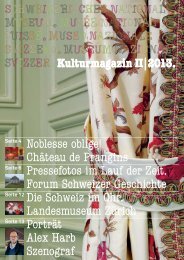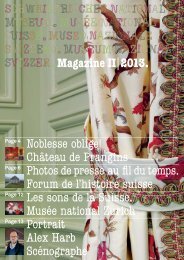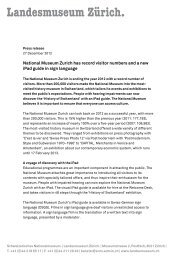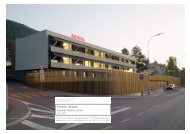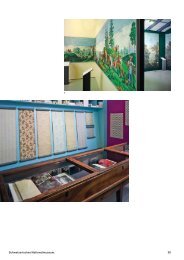Sunken Ocean-Liner Britannic's pipe organ found - high and dry
Sunken Ocean-Liner Britannic's pipe organ found - high and dry
Sunken Ocean-Liner Britannic's pipe organ found - high and dry
You also want an ePaper? Increase the reach of your titles
YUMPU automatically turns print PDFs into web optimized ePapers that Google loves.
<strong>Sunken</strong> <strong>Ocean</strong>-<strong>Liner</strong> Britannic’s <strong>pipe</strong> <strong>organ</strong> <strong>found</strong> - <strong>high</strong> <strong>and</strong> <strong>dry</strong> in the<br />
Museum of Music Automatons Seewen in Switzerl<strong>and</strong><br />
Experts are now certain they have <strong>found</strong> the <strong>pipe</strong> <strong>organ</strong> which belonged to the steamship<br />
Britannic – sister ship to the Titanic. It is in the Museum of Music Automatons at Seewen,<br />
15 km south of Basel, Switzerl<strong>and</strong>. The <strong>organ</strong> had apparently disappeared for nearly a<br />
century. The discovery was made during recent restoration work. Dr. Christoph Haenggi,<br />
Director of the museum, said “<strong>organ</strong> builders in Zürich cleaned up three normally unseen<br />
beams under the windchests, <strong>and</strong> <strong>found</strong> they each had the same indication, ‘Britanik’<br />
inscribed on them. We had independently come to an opinion that our <strong>organ</strong> had been built<br />
around 1912-1914, but information pre-1920 was missing. Historic Welte-company<br />
catalogues in our archives contain a picture of an <strong>organ</strong> installed in a ‘British steamer’. The<br />
photograph has been verified as a picture of the stairwell of Britannic. We had until now<br />
never imagined that this <strong>organ</strong> was ours!”<br />
Australian <strong>organ</strong>ist David Rumsey, consultant to the restoration, holds the same view: “It is a<br />
Welte-Philharmonie (“Philharmonic” in USA), a pneumatic <strong>organ</strong> which can be played<br />
normally from its keyboard or by pre-recorded paper rolls. From internal evidence, <strong>pipe</strong>work,<br />
construction <strong>and</strong> specification I guessed it was built around 1913. It is virtually identical to<br />
the destroyed roll-recording <strong>organ</strong> of M. Welte & Söhne in Germany at Freiburg in Breisgau.<br />
If, as now appears certain, it was intended for the Britannic, then it needed to have been<br />
finished by spring 1914 when the ship was due for launching. However fate decreed a change<br />
of destiny for both vessel <strong>and</strong> <strong>organ</strong>: with the outbreak of the First World War, the ship was<br />
requisitioned by the British navy <strong>and</strong> re-fitted as a floating hospital. In the process the <strong>organ</strong><br />
appears to have been installed, then removed <strong>and</strong> stored.”<br />
Key to illustrations 1-3: Organ builders, Kuhn Orgelbau, contractors to the Museum at Seewen, discovered<br />
these clues as to the provenance of the Welte-Philharmonie instrument under a layer of dust which had covered<br />
them for nearly 100 years.<br />
In recent years there has been much public interest in the three famous Olympic class sister<br />
ships – Olympic, Titanic <strong>and</strong> Britannic. There is no evidence that the 1911 Olympic ever had<br />
an <strong>organ</strong>. However North Atlantic passengers valued its comforts <strong>and</strong> luxuries so <strong>high</strong>ly as a<br />
mode of travel that, in 1912 the company planned to heighten these for Titanic. It seems a<br />
player <strong>organ</strong> was ordered from Welte company in Freiburg for Titanic – such instruments<br />
were prominently displayed at the great Trade Fairs of the day <strong>and</strong> were much in dem<strong>and</strong><br />
from the wealthy. There may even have been plans to include installation of a top-of-therange<br />
Welte-Philharmonie. However in the short space of time between Welte receiving the<br />
order <strong>and</strong> the maiden voyage of the Titanic it was only possible to include a small salon<br />
<strong>organ</strong>. Even this was not finished on time <strong>and</strong> never came to play upon the <strong>high</strong> seas. The so-
called Titanic-Organ, an orchestrion (playing rolls but possessing no keyboard) is today<br />
preserved in the Automatic Musical Instrument Museum at Bruchsal, Germany.<br />
Even greater luxury travel st<strong>and</strong>ards were planned for the third Olympic-Class ship,<br />
originally to be called Gigantic. However, after the sinking of the Titanic on 15 th April 1912,<br />
this ocean giant was quickly re-named Britannic. In 1911, even before the Titanic tragedy,<br />
Britannic’s keel had already been laid. Her launching was delayed after the Titanic events;<br />
eventually taking place on 26 th February 1914. The extra time was used to review plans <strong>and</strong><br />
especially to re-check security aspects. An <strong>organ</strong>, however, would have had little effect on<br />
these, so it can be assumed that Welte continued building the instrument through 1913. Its<br />
placement was to be in the great First Class stairwell, for the edification <strong>and</strong> entertainment of<br />
these most important passengers. There were two “storeys” available for it here, an ideal<br />
space, for example, to put the <strong>pipe</strong>s above <strong>and</strong> wind apparatus below. It might well also have<br />
been an unrealized objective to build a Welte-Philharmonie for the Titanic – which had an<br />
identical stairwell – but on account of the time-scales, <strong>and</strong> that ship’s destiny, this, if<br />
intended, was never completed. However, since Welte only first offered the Philharmonie for<br />
sale in 1911, a full range of models first in 1912, it looks unlikely that one was ever going to<br />
be destined for Titanic.<br />
At the end of July 1914 war broke out <strong>and</strong> the British Admiralty requisitioned all large<br />
passenger ships as troop transports or hospital ships. In December 1915 the Britannic was refitted<br />
as the latter <strong>and</strong> served for about 11 months. She ran into a German mine on 21 st<br />
November 1916 near the Isl<strong>and</strong> of Kea (Tzia) in the Aegean Sea <strong>and</strong> sank without ever<br />
having transported a civilian passenger or plied the Atlantic route. A photograph of her, fitted<br />
out for wartime service, shows the stairwell of the Britannic in an absolutely basic condition,<br />
just white-painted metallic walls. However, woodwork from the stairwell appeared later in<br />
collections, which indicates that the internal outfitting of the ship had indeed been well<br />
advanced at the time of her requisitioning in July 1914. Builders’ sketches, <strong>and</strong> a photograph<br />
in Welte’s catalogue dating from the summer of 1914, confirm that an <strong>organ</strong> the size of a<br />
Welte-Philharmonie was installed. Both this photo <strong>and</strong> a sketch prove the <strong>organ</strong>’s existence,<br />
but nothing further was <strong>found</strong> until now.<br />
Key to illustration 5 <strong>and</strong> 6: the photograph which appears in the Welte Company's 1914 catalogue <strong>and</strong><br />
corresponding drawing of unknown origin show the <strong>Britannic's</strong> staircase.
Welte caption their photograph with “Welte-Philharmonie-Orgel an Bord eines grossen<br />
englischen Dampfers“ (“Welte-Philharmonie on board a large British Steamer”) but do not<br />
identify the ship by name. This is underst<strong>and</strong>able if the <strong>organ</strong> was removed to storage in late<br />
summer of 1914 <strong>and</strong> the Britannic never sailed as a passenger ship. Since Britannic sank,<br />
then the <strong>organ</strong> could not be returned to her after the war. At this time all traces disappear.<br />
Neither relevant Harl<strong>and</strong> & Wolff, shipbuilders of Belfast, Irel<strong>and</strong>, nor Welte records are now<br />
to be <strong>found</strong>.<br />
Around 1920 the Camera-Manufacturer August Nagel (1882-1943) installed a Welte-<br />
Philharmonie <strong>organ</strong> in his imposing villa in Stuttgart. A great music lover, he naturally<br />
enough indulged in an instrument by the world famous firm from neighbouring Freiburg.<br />
Organs of this kind were to be <strong>found</strong>, symbols of wealth <strong>and</strong> status, in the residences of<br />
industrial magnates <strong>and</strong> the aristocracy. There was quite a number of them, as customer<br />
listings of Welte show. Around 1935 Nagel returned his instrument to the manufacturer for<br />
unknown reasons. In 1937 it was moved to the reception room of the Radium electric light<br />
company of Eugen Kersting (1888-1958) in Wipperfürth, Germany. The <strong>organ</strong> builder<br />
Werner Bosch (1916-1992) as an employee of Welte, slightly enlarged it <strong>and</strong> installed it<br />
there. It remained in use until the 1960s. After the second world war <strong>and</strong> the final demise of<br />
the Welte firm it came entirely under Bosch’s care. In 1961 it was used to make an LPrecording<br />
issued as Max Reger spielt eigene Orgelwerke (Max Reger plays his own <strong>organ</strong><br />
works) – also issued as Reger plays Reger – by the Electrola at Cologne, Germany (1961: 1C<br />
053-28925). It was apparently also issued by Columbia. This was produced from Welte-rolls<br />
recorded in 1913 by Reger on the Welte recording <strong>organ</strong> in Freiburg. The <strong>organ</strong> was selected<br />
as the best available for this purpose, having a specification closely corresponding to that of<br />
the original Freiburg recording <strong>organ</strong>. The reception room in Wipperfürth was then turned<br />
into a storeroom after a change of ownership. The <strong>organ</strong> was offered for sale but attracted no<br />
buyers. Eventually this was drawn to the attention of Heinrich Weiss, <strong>found</strong>er of the Museum<br />
at Seewen, who quickly acquired it for his collection. Weiss then invested some 1,500<br />
working hours in installing it <strong>and</strong> had Werner Bosch come <strong>and</strong> do the final regulation. On<br />
30 th May 1970 its completion <strong>and</strong> re-inauguration was celebrated in Seewen. Bosch was so<br />
touched by the rescue of “his” Welte-Philharmonie that he offered to sell the Seewen<br />
Museum 1,230 original rolls, which had passed into his possession on the closure of Welte.<br />
Accordingly the Seewen Museum now not only possesses an exceptional instrument with an<br />
extraordinary history, but also the original recordings made for all Philharmonie <strong>organ</strong>s.<br />
Apart from Max Reger these include famous artists of the day such as Harry Goss-Custard,<br />
Edwin Lemare, Alfred Hollins, Joseph Bonnet, William Wolstenholme, Eugène Gigout,<br />
Clarence Eddy, Marco Enrico Bossi, Karl Straube <strong>and</strong> Günter Ramin.<br />
In the course of major renovations to the Museum, the instrument – after 30 years service –<br />
was carefully removed <strong>and</strong> stored in 1998. In 2000 the building extensions were opened. The<br />
major exhibit, however, remained in storage until 2006 when restoration work could finally<br />
begin. It should be playing again after mid-2007. In the course of restoration work the<br />
pointers to the Britannic were discovered.<br />
In late 2007, including the Museum’s Open Day on 14 th October 2007, <strong>and</strong> in two evening<br />
concerts, 3 rd <strong>and</strong> 10 th November 2007, the <strong>organ</strong> will again be publicly heard in its new<br />
location in the Museum’s large KlangKunst-Saal (Hall of Auditory Arts.) Here it will form
the central part of the Museum’s collection, be included in guided tours <strong>and</strong> used for<br />
concerts. The Seewen Museum’s – or Britannic’s – Welte-Philharmonie of 1913, with its<br />
comprehensive roll collection, is musicologically an exceptionally valuable combination, a<br />
unique item of world heritage. The rolls will be able to be replayed with a very <strong>high</strong> degree of<br />
authenticity, thus providing a key to the interpretation of historic music, such as that of Max<br />
Reger, Charles-Marie Widor or Camille Saint-Saëns, <strong>and</strong> giving retrospective detail of the<br />
performance practices of an important era from which virtually no other recordings exist. An<br />
original roll-recording apparatus of Welte is also held in the Museum’s collection.<br />
David Rumsey is convinced: “everything leads us to the conclusion that this <strong>organ</strong> was the<br />
one intended for the Britannic, installed <strong>and</strong> photographed in situ, but removed in mid-1914<br />
<strong>and</strong> stored by Welte in Freiburg. There it escaped the fate of the ship <strong>and</strong> survived the First<br />
World War. From the beginning it was planned as a larger <strong>organ</strong> than Titanic’s - the largest<br />
<strong>and</strong> most modern of its kind. Organs on vessels began in fiction with <strong>organ</strong>ist-Captain Nemo<br />
in Jules Verne’s 20,000 Leagues under the Sea in 1869/70. To all intents <strong>and</strong> purposes,<br />
however, they were only ever realized aboard ships twice in history, just over 40 years later –<br />
Titanic <strong>and</strong> Britannic. It is remarkable that both <strong>organ</strong>s managed somehow to avoid their<br />
destinies of watery graves, ending up on <strong>dry</strong> l<strong>and</strong>, quite safe from the ocean’s grasp. The<br />
museum at Seewen is some 610 metres above sea level!”<br />
Dates:<br />
- Restoration work on the <strong>organ</strong> : April 2006 to April 2007<br />
- Return to, voicing <strong>and</strong> regulation in the Museum: May to September 2007<br />
- Contracted <strong>organ</strong> builders: Orgelbau Kuhn AG, Männedorf, Switzerl<strong>and</strong><br />
Organ committee: Dr. Christoph E. Hänggi, Georg Hofmeier, Bernhard Prisi,<br />
David Rumsey, Dr. h.c. Heinrich Weiss<br />
- Open Day: 14 th October 2007<br />
- Concert with David Rumsey: 3 rd November 2007<br />
- Concert with George Gruntz: 10 th November 2007<br />
For further information, in German or English (other languages also available), contact:<br />
Dr. Christoph E. Haenggi<br />
Museum für Musikautomaten<br />
CH-4206 Seewen Switzerl<strong>and</strong><br />
+41 61 915 98 80<br />
musikautomaten@slm.admin.ch<br />
www.l<strong>and</strong>esmuseen.ch/seewen<br />
or<br />
David Rumsey<br />
Bruderholzrain 28<br />
CH-4059 Basel Switzerl<strong>and</strong><br />
+41 61 261 91 10<br />
davidrumsey@bluewin.ch<br />
www.davidrumsey.ch



